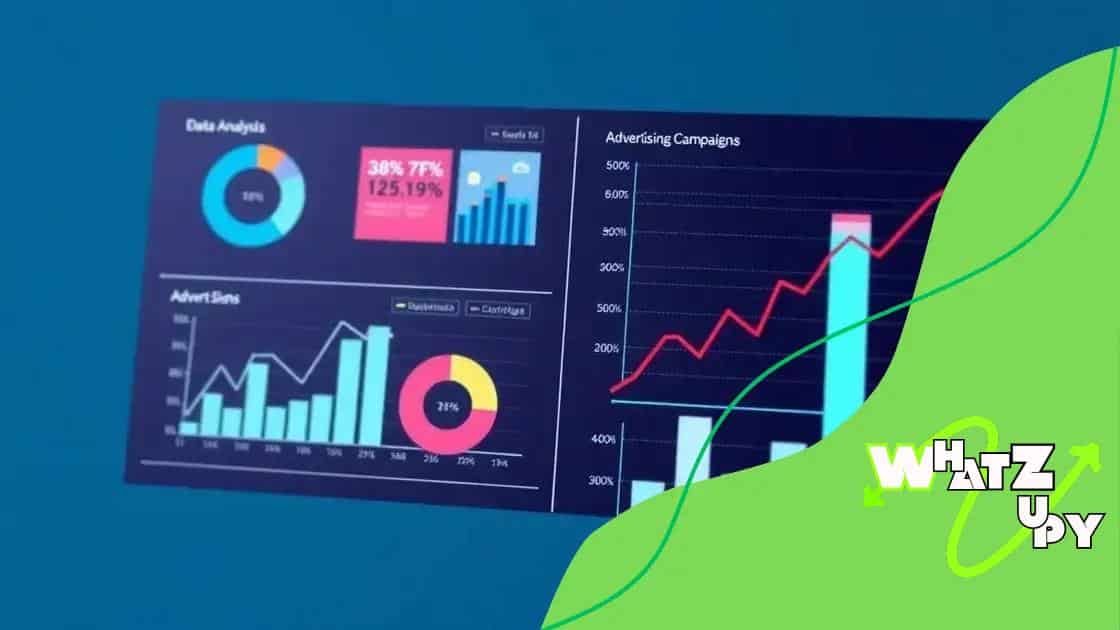Predictive analytics for optimizing ad spend

Predictive analytics for optimizing ad spend utilizes data analysis to forecast customer behaviors, allowing businesses to improve targeting, enhance ROI, and streamline marketing strategies effectively.
Predictive analytics for optimizing ad spend changes how businesses allocate their advertising budgets. Imagine being able to predict which campaigns will yield the highest returns! In this article, we’ll explore this fascinating approach and how it can transform your marketing strategies.
Understanding predictive analytics in marketing
Understanding predictive analytics in marketing is essential for any business aiming to maximize its advertising efforts. This approach involves analyzing data to forecast future outcomes, helping businesses make informed decisions.
It starts by collecting historical data on customer behaviors and campaign performance. Once the data is gathered, advanced algorithms process it to identify patterns. This enables marketers to predict which strategies will likely succeed.
Key Components of Predictive Analytics
This powerful tool consists of several components that work together seamlessly:
- Data Collection: Gathering information from various sources, including online interactions, sales, and customer feedback.
- Data Analysis: Using statistical methods and machine learning techniques to interpret the data.
- Model Building: Creating predictive models that forecast outcomes based on identified patterns.
Once the models are built, they can be used to evaluate different marketing strategies. By running simulations, marketers can see potential results before committing their budgets. This is where the real magic happens.
Benefits of Predictive Analytics in Marketing
Implementing predictive analytics offers several advantages. For starters, it allows marketers to customize campaigns to target specific audiences. Understanding customer preferences ensures that advertisements resonate well, effectively increasing engagement.
Additionally, businesses can allocate their budgets more wisely. By predicting which ads will drive sales, companies avoid wasting money on ineffective campaigns. This leads to improved ROI and overall business growth.
As technology continues to evolve, the capabilities of predictive analytics grow stronger. Businesses that embrace these changes will find themselves at the forefront of marketing innovation.
Key benefits of using predictive analytics
The key benefits of using predictive analytics in marketing are game-changers for businesses. By employing this data-driven approach, companies can significantly enhance their decision-making processes.
One major advantage is the ability to understand customer behavior. Predictive analytics analyzes past interactions and preferences, enabling marketers to tailor campaigns that resonate with target audiences.
Improved Targeting
With predictive analytics, businesses can focus their efforts on the right customers. This leads to:
- High conversion rates: Targeted ads are more likely to convert leads into sales.
- Personalization: Customers appreciate personalized marketing, leading to better engagement.
- Increased efficiency: Less wasted ad spend on ineffective strategies.
Another benefit is the improved allocation of marketing budgets. Predictive analytics helps in identifying which campaigns will yield the highest returns. As a result, businesses can invest their money where it counts most.
Enhanced ROI
Tracking and measuring ROI becomes more straightforward with predictive models. Marketers can forecast outcomes based on historical data and make informed adjustments. This continuous optimization process leads to:
- Better results: By learning from past performance, businesses can refine their strategies.
- Long-term growth: Investing in high-performing channels ensures sustainable profitability.
- Strategic insights: Data-driven decisions often yield insights that improve overall marketing strategies.
Incorporating predictive analytics also fosters a competitive edge. As more businesses adopt this technology, those that lag behind risk missing out on key advantages.
Ultimately, the insights gained from predictive analytics empower companies to not only meet customer expectations but also to stay ahead of market trends.
How to implement predictive analytics for ads

Implementing predictive analytics for ads can dramatically improve your campaign performance. The process may seem complex, but breaking it down into manageable steps makes it achievable.
The first step is to define your goals. Are you aiming to increase brand awareness, boost sales, or enhance customer engagement? Clear objectives help you determine what data to collect and analyze.
Data Collection
Once goals are set, it’s time to gather data. Here are some sources to consider:
- Website Analytics: Use tools like Google Analytics to track visitor behavior and interactions.
- Customer Surveys: Collect feedback directly from customers to understand their preferences.
- Social Media Insights: Analyze engagement metrics to identify trends.
After collecting data, the next step is analysis. Leverage software tools that specialize in data analysis to extract valuable insights. These tools can identify patterns and trends that inform your strategy.
Building Predictive Models
Creating predictive models is a critical phase. Start with the data you’ve gathered and use statistical techniques to identify correlations. For instance, you might find that certain demographics respond better to specific ad types.
As you build models, it’s essential to test them regularly. This ensures they remain accurate over time. This continuous adjustment helps maintain relevance in changing markets.
Implementation and Monitoring
Once models are refined, implement the strategies across your ad platforms. It’s essential to monitor results closely. Analyze the performance of your ads using the key performance indicators (KPIs) established earlier.
If something isn’t working as expected, don’t hesitate to pivot based on your findings. The beauty of predictive analytics is its ability to adapt based on real-time data.
By following these steps, businesses can effectively implement predictive analytics for ads, leading to improved targeting, enhanced ROI, and better overall marketing strategies.
Challenges in adopting predictive analytics
Adopting predictive analytics can bring numerous benefits, but it also comes with challenges. Recognizing these obstacles is the first step toward successful implementation.
One significant challenge is data quality. For predictive analytics to be effective, businesses must ensure they have accurate and clean data. Inaccurate data can lead to faulty insights and misguided decisions.
Data Integration
Integrating data from various sources is another hurdle. Companies often gather information from different platforms, which may not be compatible. This lack of integration can cause delays and inconsistencies.
- Inconsistent formats: Data from different sources might use varying formats, complicating analysis.
- Data silos: Information might be trapped within departments, making it hard to access and analyze.
- Real-time data: Capturing and processing real-time data can be technically challenging.
Another challenge is the need for skilled personnel. Implementing predictive analytics requires professionals who understand the technology and can interpret results. Many companies struggle to find and retain these specialized skills, leading to operational gaps.
Change Management
Additionally, resistance to change within an organization can slow down adoption. Employees may be hesitant to embrace new technologies, fearing job displacement or changes in their workflow. It’s crucial for leadership to foster a culture that embraces innovation.
Companies also face budget constraints. Investing in the necessary tools and training can be costly. Without appropriate funding, it becomes difficult to implement and maintain predictive analytics systems.
Understanding these challenges is vital for organizations looking to adopt predictive analytics. By addressing these issues thoughtfully, companies can pave the way for successful adoption and harness the power of data.
Real-world examples of successful ad optimization
Real-world examples of successful ad optimization using predictive analytics can illustrate the power of data-driven decision-making. Many companies have effectively leveraged this approach to enhance their advertising efforts.
One notable case is a global retail brand that implemented predictive analytics to refine its digital marketing strategy. By analyzing past purchase behavior, the brand identified customer segments that were most likely to respond to specific campaigns. This led to personalized ad content that significantly increased engagement rates.
Increased Conversion Rates
As a result, the company saw a 30% boost in conversion rates. This improvement was largely due to targeting the right customers with the right messages at the right times. The predictive models allowed the marketing team to allocate budgets more effectively, focusing on channels that delivered the highest returns.
Case Study: A Travel Company
Another example is a travel company that used predictive analytics to optimize its ad spend during peak travel seasons. By forecasting travel trends, the company tailored its advertising campaigns to align with customer interests.
- Targeted Promotions: The company created tailored promotions for specific travel destinations based on data insights.
- Dynamic Pricing: By predicting demand fluctuations, it adjusted pricing strategies to maximize revenue.
- Enhanced Customer Engagement: The approach resulted in personalized marketing messages that resonated with potential travelers.
This strategy led to a significant increase in bookings, demonstrating how effective ad optimization can be achieved through data analysis.
Moreover, a tech startup also utilized predictive analytics to improve its online advertising campaigns. By continuously monitoring user interactions, the startup refined its strategies in real-time, resulting in a 25% decrease in customer acquisition costs. These examples underscore the value of implementing predictive analytics as a key element of marketing success.
In conclusion, adopting predictive analytics can significantly elevate your advertising strategy. By understanding customer behavior and optimizing ad spend, businesses can achieve impressive results. Real-world examples showcase how companies like retail brands and travel agencies have successfully implemented these techniques to improve engagement and conversion rates. As data quality and integration become easier to manage, the future of marketing looks promising with predictive analytics as a foundational tool. Embracing this approach allows businesses to stay ahead in a competitive market and meet customer needs more effectively.
FAQ – Frequently Asked Questions about Predictive Analytics in Advertising
What is predictive analytics?
Predictive analytics is a data-driven approach that uses historical data and statistical algorithms to forecast future outcomes and behaviors.
How can predictive analytics improve my advertising efforts?
By analyzing customer behavior and preferences, predictive analytics helps tailor campaigns for better targeting, increasing engagement and conversion rates.
What are some challenges in implementing predictive analytics?
Challenges include ensuring data quality, integrating data from various sources, and finding skilled personnel to analyze and interpret results.
Can small businesses benefit from predictive analytics?
Absolutely! Predictive analytics can help small businesses optimize their marketing strategies and budget allocation, ultimately leading to greater ROI.





